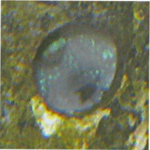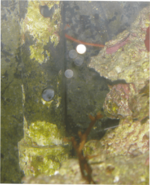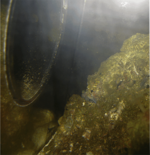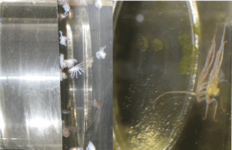-
Looking to buy a cephalopod? Check out Tomh's Cephs Forum, and this post in particular shares important info about our policies as it relates to responsible ceph-keeping.
You are using an out of date browser. It may not display this or other websites correctly.
You should upgrade or use an alternative browser.
You should upgrade or use an alternative browser.
Kooah's Hatchlings - O.briareus
- Thread starter DWhatley
- Start date
-
- Tags
- briareus hatchlings
Cassy is funny (and I am so getting attached to her). She seems to know the flashlight is going to bring food but hides under a particular overhang where I can only see the searching arms. Tonight she I saw her moving around in other nearby rock but she made her way to the one where she has been eating. Once she snags the shrimp (she seems to understand better that the stick is only delivering the food now or maybe the food is just easier to remove now that the food is larger) she comes out and eats where I can see her as long as I keep her in shadow. I was able to get her to eat around 10:30 but have not yet found the more recluse Tatanka.
Happy birthday to the little octopuses. D, are you sure none of the others are left, except one?
Nancy
Nancy
I have two, Cassy and Tatanka (AKA SittingBull) and this week both have taken food every night from a pipette. It may be that the tanks are running thin on findable food or, at least in Cassy's case, they are recognizing an easy meal. Kara sent me a variety of stuff to try including small mithrax, hermit and decorator crabs. I put the decorators into the tanks for them to hunt and find along with a few of the hermits. I will feed the mithrax (sadly) by hand if I can and am experimenting with an idea on how to feed the hermits. If I can get them to take hermits out of the shell, they may hunt them on their own.
I don't THINK there are any others. There is a slim possibility that Sam (in Cassy's tank) is still alive but I think, because of her size, I just saw Cassy in two places. I have only seen Tatanka in the tube tank for well over a week. He uses both sides so I really have to hunt for him. At first I wondered if there were still two but I have seen him cross the tubes and I have not seen two at one sitting.
I don't THINK there are any others. There is a slim possibility that Sam (in Cassy's tank) is still alive but I think, because of her size, I just saw Cassy in two places. I have only seen Tatanka in the tube tank for well over a week. He uses both sides so I really have to hunt for him. At first I wondered if there were still two but I have seen him cross the tubes and I have not seen two at one sitting.
- Joined
- Jun 10, 2010
- Messages
- 266
We continue to follow the adventures with keen interest. One side-effect of the extra food in the tank may be a reduced desire to take hand-offered meals.
Just remember my experience - four months with my face pressed to the glass and I never saw her until she officially "came out".
Nancy
Nancy
I have had the extreme pleasure of recently working with one of the "original" marine aquarist, biologist, hobbyist, author and gentlemen of our time (especially mine  ) and was able to bend his ear a little on my octo project while doing work on creating a blog for his latest research. Martin Moe gave me the following words of wisdom:
) and was able to bend his ear a little on my octo project while doing work on creating a blog for his latest research. Martin Moe gave me the following words of wisdom:
Martin has been trying to solve the mystery of mass producing Diadema urchins (an animal with true metamorphous and a lengthy pelagic stage) for over 5 years and the, "all you have to do" part is definitely intended as tongue in cheek. He solved the spawning issues and the pelagic transformation by last year so I was surprised to discover that he is still struggling with the benthic transition. If anyone is going to MACNA in Orlando over the Labor Day weekend, he will be giving a talk on the project.
 ) and was able to bend his ear a little on my octo project while doing work on creating a blog for his latest research. Martin Moe gave me the following words of wisdom:
) and was able to bend his ear a little on my octo project while doing work on creating a blog for his latest research. Martin Moe gave me the following words of wisdom:I think the reason so many marine organisms have such a huge reproductive capacity is because so many are lost in the larval and early juvenile phase. And I don't think that it is a "weakness" in the early juvenile that prevents survival as much as the hand of "fate" in the time and place in which the juvenile finds itself. According to this theory, juveniles produced by human culture, assuming that the larvae culture parameters produced healthy late larvae, are capable of a huge percentage survival if the environmental conditions are optimum for the juveniles of the cultured species. And it is up to the human culturist to research, develop, and provide these conditions. Sometimes this is easy and sometimes very hard, but for all organisms these conditions exist somewhere, sometime, and all that needs to be done is to identify them and provide them. Then the late larvae, early juveniles, will do the rest. So this all you have to do with your octopus and all I have to do with my Diadema. Somehow that old saying, "Easier said than done" comes to mind.
Martin has been trying to solve the mystery of mass producing Diadema urchins (an animal with true metamorphous and a lengthy pelagic stage) for over 5 years and the, "all you have to do" part is definitely intended as tongue in cheek. He solved the spawning issues and the pelagic transformation by last year so I was surprised to discover that he is still struggling with the benthic transition. If anyone is going to MACNA in Orlando over the Labor Day weekend, he will be giving a talk on the project.
Neal wanted to feed Cassy tonight and I gave him my spiel on her typical behavior of late and how to locate and feed her. Surprisingly, she did exactly what I said she would and in very short order, how unoctopus like . Tatanka was slightly off from my prediction but only in that he was easy to find and feed, instead of coming out later and having to be located multiple times before he accepted food. I am encouraged that they may be learning to accept food from me (again) and hope Tatanka will start coming to one spot for dinner like Cassy seems to be doing.
. Tatanka was slightly off from my prediction but only in that he was easy to find and feed, instead of coming out later and having to be located multiple times before he accepted food. I am encouraged that they may be learning to accept food from me (again) and hope Tatanka will start coming to one spot for dinner like Cassy seems to be doing.
Tonight I fed hermits out of the shell (I froze them in the shell and then thawed them, fun to get into an adjusted pipette). I have the live crabs and some small hermits in there for them to find but think I will continue to feed the larger hermits this way as they have a nice chunk of meat on their bodies and I can be sure the octos are getting at least one larger piece of meat each day. I do find myself apologizing to the hermits when I freeze them but I hope is it a better death than being eaten alive.
Tonight I fed hermits out of the shell (I froze them in the shell and then thawed them, fun to get into an adjusted pipette). I have the live crabs and some small hermits in there for them to find but think I will continue to feed the larger hermits this way as they have a nice chunk of meat on their bodies and I can be sure the octos are getting at least one larger piece of meat each day. I do find myself apologizing to the hermits when I freeze them but I hope is it a better death than being eaten alive.
Isn't Tatanka the one you used to call Sitting Bull? I really liked the name Sitting Bull!
Glad to hear that you have two who are coming out to eat.
Nancy
Glad to hear that you have two who are coming out to eat.
Nancy
Yes, and when the name was altered I put a link to a history of Sitting Bull on the name. Tatanka-Iyotanka is something close in English to the Indian chief's Indian name. Neal did the research on his own so I think he wanted something a little more obscure for him without really changing my choice, adding the Iyotanka was too much though.
I should have known! His name is still Sitting Bull, just taken one step further!
Nancy
Nancy
Tatanka Pictures
I did not find Tatanka last night so I took extra time tonight to try to locate him and spotted him in the most unlikely of places. He was hiding in the return water tube (PVC pipe with holes drilled front and back and attached to a SCWD). I tried putting the days meal in the hole but he disappeared. I thought I spotted him further up the pipe but while I was trying to feed in that hole I spotted him gliding to the opposite side of the tank. He was shy of the pipette but once he took the shrimp he spread out on the tank wall and stayed visible for quite awhile. Needless to say I grabbed the camera and attempted a few photos.
The picture with the two photos joined together is the best I could do to show growth. The left crop is hatching day and the second a resized view of Tatanka next to the same crossover 6" tube.
I did not find Tatanka last night so I took extra time tonight to try to locate him and spotted him in the most unlikely of places. He was hiding in the return water tube (PVC pipe with holes drilled front and back and attached to a SCWD). I tried putting the days meal in the hole but he disappeared. I thought I spotted him further up the pipe but while I was trying to feed in that hole I spotted him gliding to the opposite side of the tank. He was shy of the pipette but once he took the shrimp he spread out on the tank wall and stayed visible for quite awhile. Needless to say I grabbed the camera and attempted a few photos.
The picture with the two photos joined together is the best I could do to show growth. The left crop is hatching day and the second a resized view of Tatanka next to the same crossover 6" tube.
Attachments
Tatanka (AKA SittingBull) was inside the return pipe tonight and easy to find. This time when I offered shrimp to the "viewing hole" I also watched the back of the pipe and caught him "escaping". He took the offered shrimp and went back into the pipe so if he continues to use the pipe for a den, I will wait until he is a little further away to offer him food.
Cassy did not show up in her usual spot (acting more like an unpredictable octo now) but a search of the tank found her all the way on the left and on the back wall. Easy to feed but she too disappeared as soon as she took her food.
It is interesting to note (once again) that both octos are hanging out close to the current source. Tatanka directly in the return pipe and Cassy directly in-line with the Koralia. Kooah chose a den to brood where the Koralia would "blow" on the eggs and the same was true of Maya. Both of my surviving hatchlings spent time in the filter socks and it may be more than food that kept them alive. I am beginning to put more importance on flowing water and wonder if it has something to do with pushing water over their gills, especially in the first weeks.
Cassy did not show up in her usual spot (acting more like an unpredictable octo now) but a search of the tank found her all the way on the left and on the back wall. Easy to feed but she too disappeared as soon as she took her food.
It is interesting to note (once again) that both octos are hanging out close to the current source. Tatanka directly in the return pipe and Cassy directly in-line with the Koralia. Kooah chose a den to brood where the Koralia would "blow" on the eggs and the same was true of Maya. Both of my surviving hatchlings spent time in the filter socks and it may be more than food that kept them alive. I am beginning to put more importance on flowing water and wonder if it has something to do with pushing water over their gills, especially in the first weeks.
Hmmm very interesting. Leg's tank, now Pen's, has a lot of current too, I wonder if that's why she did as well as she did.
The little pelagic hatchlings would be tossed around a lot in the current and the briareus were out on the glass for a week (with very short but suckered arms) so they were not really pelagic but at one week there was a dramatic change and most died. Air stones are thought to be a problem with getting air into the mantle but the flowing water into the filter sock (there were bags of charcoal in them so the octos did not get the direct current) would not create this problem and still give flow so next time we have hatchlings of either kind, I am going to suggest putting some in this kind of environment. It may be that they need more oxygen than we give them (also accomplished with the open water flow but not directly with the Koralias). I think Thales is leading toward some thoughts around some similar observations with cuttles as well.
Similar threads
- Replies
- 14
- Views
- 318
- Replies
- 10
- Views
- 573




